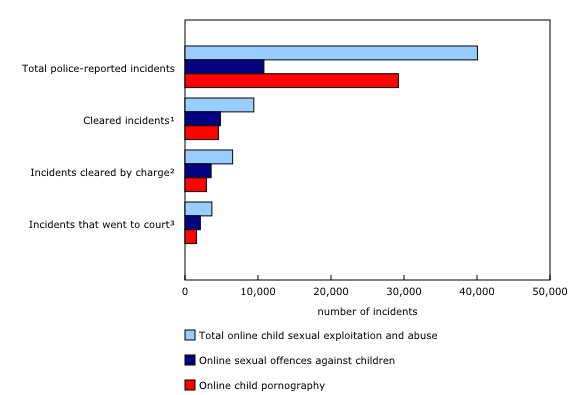Criminal justice pathways of online child sexual exploitation and abuse incidents in Canada, 2014 to 2020
Released: 2023-03-09
Online child sexual exploitation and abuse has been increasingly coming to the attention of police in Canada in recent years. Previously published police-reported data showed that this type of crime has been increasing since 2014, when national-level data first became available, with a notable rise during the first year of the COVID-19 pandemic.
The Juristat Bulletin—Quick Fact article, "Online child sexual exploitation and abuse: Criminal justice pathways of police-reported incidents in Canada, 2014 to 2020," released today, provides information which highlights the progression of online child sexual exploitation and abuse incidents, from when they come to police attention to when they are processed in court, the characteristics of these incidents, court case outcomes and comparisons with other types of crime.
Overall, one in four police-reported incidents of online child sexual exploitation and abuse are solved
From 2014 to 2020, police reported 40,059 incidents of online child sexual exploitation and abuse. Nearly three-quarters (73%) of these incidents were offences related to possessing, accessing, making or distributing child pornography; the remainder (27%) involved another type of online sexual offence against children.
Overall, one in four incidents of online child sexual exploitation and abuse (24%) were solved, or cleared, meaning police identified an accused person in relation to the incident. The majority (76%) of incidents were not solved, representing the largest drop-off of these incidents as they progressed from police to courts. This was particularly the case for police-reported online child pornography incidents, 84% of which were not solved. This relatively low clearance rate reflected the challenges and complexities of investigating online offences, including the difficulty of identifying victims and locating offenders.
Once an accused person was identified, charges were laid or recommended by police in the majority (69%) of incidents. Likewise, once charges were laid or recommended, more than half (56%) of these incidents proceeded to court. The remaining 44% of incidents where charges were laid by police did not successfully link to a completed charge in court within the reference period of this study.
Fewer than 1 in 10 police-reported incidents of online child sexual exploitation and abuse proceed to court
During the period of this study, 3,680 incidents proceeded to court, representing 9% of all incidents reported to police. Incidents related to online child pornography (5%) were less likely to proceed to court than other online sexual offences against children (19%).
In comparison, over the same period, 36% of all incidents of physical assault reported by police ultimately proceeded to court.
Once in court, nearly four in five cases result in a guilty finding
The majority of incidents of online child sexual exploitation and abuse where links to a court case were established resulted in a guilty finding once completed, though not necessarily for the offence originally identified by police. In total, 77% of cases related to an online child sexual exploitation and abuse incident resulted in a conviction for any offence.
After a guilty finding was rendered, 86% of cases in adult courts resulted in a custody sentence. In contrast, for police-reported physical assault incidents that proceeded to court, 35% of guilty cases resulted in a custody sentence.
Other differences that were noted in court outcomes depended on incident, accused and victim characteristics. For example, court cases linked to police-reported incidents where men and boys were accused more often resulted in charges being laid or recommended by police, proceeding to court and a guilty finding. Additionally, once solved, incidents with younger victims and accused friends or family members more often ended in a guilty finding for a sexual offence.
Note to readers
To infer criminal justice outcomes for police-reported incidents of online child sexual exploitation and abuse, an initial Incident-based Uniform Crime Reporting (UCR) Survey file was created from production files, which contained available personal and incident information to be used for linkage to the Integrated Criminal Court Survey data. The initial UCR Survey file contained all police-reported incidents that were reported from 2014 to 2020 where a cybercrime violation was identified as one of the violations included in the definition of online child sexual exploitation and abuse.
The Criminal Code does not have a specific definition for the broad crime of online child sexual exploitation and abuse, but information collected by the UCR Survey, including a cybercrime indicator, can be used in conjunction with Criminal Code definitions to identify criminal incidents that fall within the scope of this crime.
Incidents involving child pornography where a victim is not identified are reported to the UCR Survey with the most serious violation being "child pornography." When a victim is identified, the incident is reported to the UCR Survey with the most serious violation being "sexual assault," "sexual exploitation" or "other sexual offences against children," and "child pornography" may be reported as a secondary violation.
The category "other sexual offences against children" is a catch-all category that encompasses all sexual violations against children (excluding child pornography), such as sexual interference, sexual exploitation or sexual assault, which were facilitated by or involved the use of technology.
For more information on the data linkage, methodology and data sources used in this study, please consult the full Juristat article.
Products
The article "Online child sexual exploitation and abuse: Criminal justice pathways of police-reported incidents in Canada, 2014 to 2020" is now available as part of the publication Juristat Bulletin—Quick Fact (85-005-X).
Contact information
For more information, or to enquire about the concepts, methods or data quality of this release, contact us (toll-free 1-800-263-1136; 514-283-8300; infostats@statcan.gc.ca) or Media Relations (statcan.mediahotline-ligneinfomedias.statcan@statcan.gc.ca).
- Date modified:

